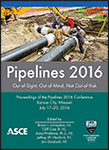Degrees of Freedom: Value/Risk Engineering for Large Diameter Pipe in Soft Ground Conditions
Publication: Pipelines 2016
Abstract
It is well understood in the civil engineering industry that the economy of flexible pipe systems relies almost entirely on the pipe-soil structural interaction. As correctly noted by one of our generation’s preeminent steel pipe design researchers, Dr. Reynold Watkins, the design of flexible pipes is largely dependent on the surrounding soils. The selection of flexible pipe materials and the design of the flexible pipeline system begins with and depends almost entirely on the ground conditions through which the pipeline will be constructed. The Tarrant Regional Water District (TRWD) and Dallas Water Utilities (DWU) began design of the Integrated Pipeline Project (IPL) in 2008 and have been advancing the art and science of large diameter pipeline project delivery ever since. The $2.3 billion IPL is a joint project between DWU and TRWD and will, when completed, include 150 miles of pipeline from Lake Palestine to Lake Benbrook. The pipeline crosses a number of challenging obstacles and passes through a number of highly variable ground conditions, from rippable (soft) rock to running, saturated sands and everything in between. The 13-mile long alignment of IPL Section 15-2 crosses the Waxahachie Creek valley west of IH-45 before following a long, gentle ridgeline roughly between Ennis and Waxahachie, Texas. The pipeline crosses some very design-challenging soils, including the notorious, heave-susceptible Blackland Prairie. The geotechnical/geophysical program prepared by the Program Team noted a number of “Areas of Geologic Concern” in Section 15-2, most notably in the “Waxahachie Creek Bottoms,” an alluvial valley with a broad floodplain and shallow, water-bearing sands within and just beneath the “typical” trench profile. The design team worked collaboratively with the pipeline owners and their program management team to develop best-value design and construction procurement approaches to deliver the project in a way that fairly attributed and mitigated the ground condition risks while assuring the best life-cycle value for the owners. This paper describes the project constraints faced and approaches taken to mitigate both design and construction risks. These approaches included clearly defining the design intent that was predicated on assumed ground/trench conditions and the following construction inspection and management practices: Clear delineation of areas of geotechnical concern in the bidding documents; Clear definition of the ground conditions assumptions made in pipe and trench envelope design in the bidding documents; Definitive pre-construction validation of ground conditions ahead of material procurement; Validation of in-situ trench conditions during pipeline installation; Provisions for alternative trench and backfill envelopes in both the bid schedule and plan and specifications that equitably mitigate bidding and construction cost risks related to ground conditions.
Get full access to this article
View all available purchase options and get full access to this chapter.
Information & Authors
Information
Published In
Copyright
© 2016 American Society of Civil Engineers.
History
Published online: Jul 14, 2016
Authors
Metrics & Citations
Metrics
Citations
Download citation
If you have the appropriate software installed, you can download article citation data to the citation manager of your choice. Simply select your manager software from the list below and click Download.
